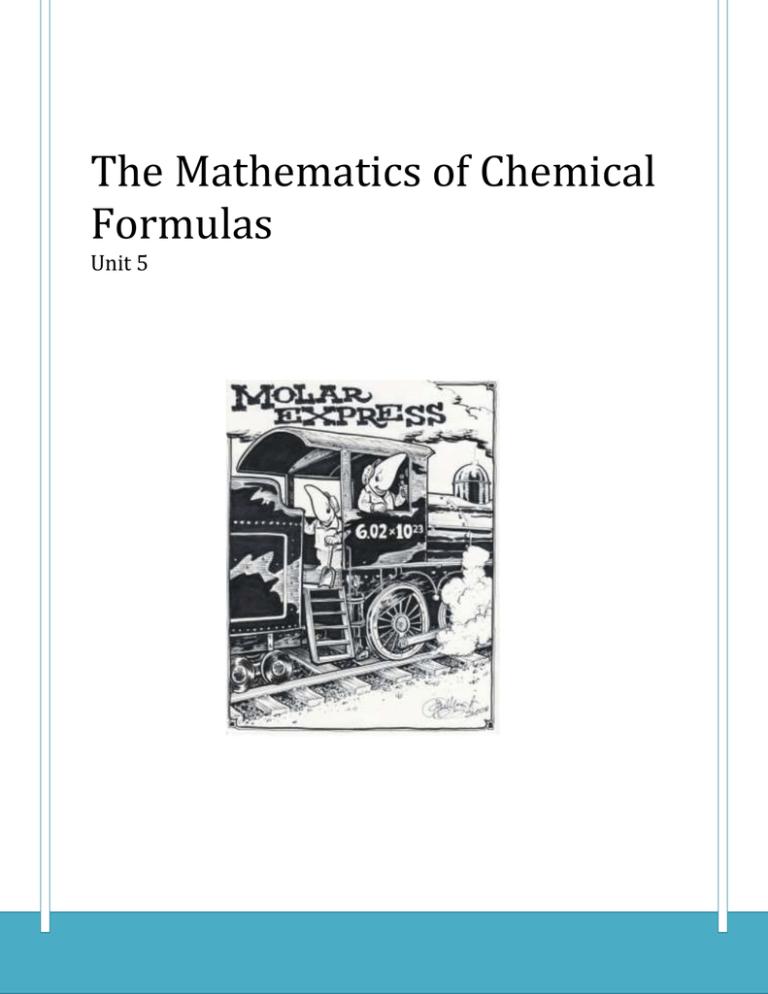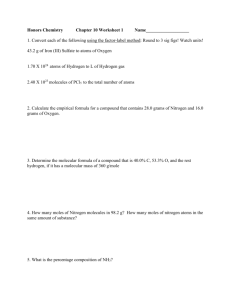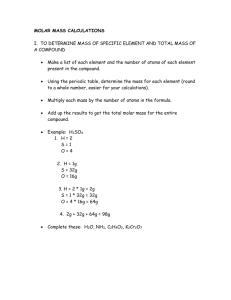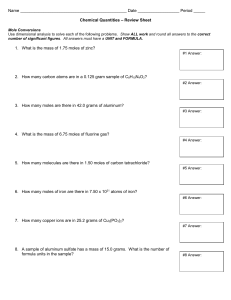The Mathematics of Chemical Formulas
advertisement

The Mathematics of Chemical Formulas Unit 5 Stoichiometry Do the following conversions. Show your work with units for each problem designated with an (*). Express your answer to the correct number of significant figures. A. Convert the following to moles. 1. 1.204 x 1023 atoms of He* 2. 3.01 x 1023 atoms of Cu 3. 3.96 x 1014 atoms of Fe 4. 1000. atoms of Ar 5. 24.0 grams of S* 6. 100.0 grams of Na 7. 0.0056 grams of Ne 8. 3.90 x 1025 molecules of NaCl 9. 4.00 x 1020 atoms of Ag 10. 1200. atoms of Sn 11. 320. grams of NI3 12. 12.0 grams of silver nitrate* 13. 0.980 grams of ferric iodate 14. 1.87 x 105 grams of H2O 15. 510 grams of Al2S3 B. Convert each of the following to grams. 16. 10.0 moles of Na* 17. 2.20 moles of Sn 18. 0.00456 moles of Ag 19. 5.00 moles of Au 20. 1.64 x 10-5 moles of B 21. 6.70 moles of NH3* 22. 123.9 moles of CO2 23. 45.9 moles of copper (I) oxide 24. 1.50 x 10-3 moles of sulfur trioxide C. Convert the following to number of particles. 25. 2.0 moles of C* 26. 0.0786 moles of La 27. 3.56 x 104 moles of Zn 28. 2.00 moles of CO2* 29. 1.80 moles of phosphorus trichloride 30. 3.40 moles of silver nitrate D. Convert the following to mass in grams. 31. 6.02 x 1023 atoms of Ca* 32. 1.34 x 1021 atoms of Bi 33. 340. atoms of Ni 34. 1000. atoms of Mo 35. 3.60 x 1023 molecules of water* 36. 2.34 x 105 molecules of zinc chloride 37. 3.67 x 1020 molecules of copper (II) chloride 38. 1 molecule of H2O E. Convert the following to number of particles. 39. 740 grams of Al* 40. 294 grams of Au 41. 6.35 grams of Cu 42. 2000. grams of Mg 43. 1.00 grams of Li 44. 72 grams of HCl* 45. 9.0 grams of H2O 46. 500. grams of NO 47. 1.00 grams of carbon tetrachloride* 48. 0.0567 grams of calcium chloride 49. 7.56 x 10-6 grams of dihydrogen sulfide 50. 1.45 grams of Cl2 Determining Empirical Formulas Determine the empirical formula for each of the following. Show your work with units. 51. 3.611 g of Ca; 6.389 g of Cl 52. 0.150 g of S; 0.150 g of O 53. 0.461 g of C; 0.039 g of H 54. 1.645 g of N; 0.355 g of H 55. 20.23% Al; 79.77% Cl 56. 24.74% K; 34.76% Mn; 40.50% O 57. 42.88% C; 57.12% O 58. 27.29% C; 72.71% O 59. A compound that is composed of silver and oxygen is heated to drive off the oxygen. Given the following data, what is the empirical formula of the compound? Mass of compound before heating: Mass of compound after heating: 2.74 g 2.55 g 60. 2.646 g of Al; 2.355 g of O 61. 72.36% Fe; 27.64% O 62. 41.12% N; 11.83% H; 47.05% S 63. 2.16 g of Al; 3.85 g of S; 7.68 g of O 64. Nitrogen combines with oxygen to form several different compounds. Calculate the empirical formulas of the compounds if they contain the following percentages of nitrogen: 30.43%; 25.93%; 36.84%; 46.67% and 63.63%. 65. Fats make up a major portion of all soaps. A fat used in many soaps is 76.6% carbon, 11.3% oxygen, and 12.1% hydrogen. What is the formula of the fat? Determining Empirical Formulas of Hydrates 66. A compound has a formula of Zn3(PO4)2 xH20. The hydrate is composed of 84.3% zinc phosphate and 15.7% water. What is the value of x? 67. A hydrate consists of 22.54 g of Na; 5.88 g of C; 23.52 g of O and 88.2 g of H2O. What is the formula of the hydrate? What is the name of the hydrate? 68. A hydrate consists of 4.51 g of P; 10.01 g of Na; 9.24 g of O and 31.24 g of H2O. What is the formula of the hydrate (helpful hint: I have not put the elements in the correct order)? 69. A student heated a hydrate with a formula of NaH2PO4 xH2O. She gathered the following data: Crucible and cover 23.96 g Crucible, cover and hydrate 29.23 g Crucible, cover and anhydrous salt 26.20 g What is the formula of the hydrate? Determining Molecular Formulas Determine the molecular formula for each of the following. Show your work with units. 70. A compound contains 30.45% nitrogen and 69.55% oxygen. What is the molecular formula if the molecular mass is 92.02 g/mol? 71. A compound has a molecular mass of 30.0 g/mol. If the compound is shown to contain 42.4 g of H and 169.7 g of C, what is the empirical and molecular formula of the compound? 72. A compound has a molecular mass of 391.5 g/mol. If the compound is shown to contain 8.6 g of boron and 302.2 g of iodine, what is the empirical and molecular formula? 73. A compound having an approximate molecular mass of 165-170 g/mol has the following % composition by mass: 42.87% carbon; 3.59% hydrogen; 28.55% oxygen and 25.00% nitrogen. Determine the empirical and molecular formula. 74. Octane, a compound of hydrogen and carbon found in gasoline, has a molecular mass of 114.26. If the percentage of hydrogen in octane is 15.75, what is the molecular formula of the compound? Percent Composition A. Find the percent composition of each of the elements in the following compounds. Show your work. 75. NaCl 76. Ca(OH)2 77. H2O 78. Na2SO4 79. BaCl2 B. Calculate the percent composition of the metal in each one of the following compounds. Show your work. 80. CaO 81. Na2O 82. Fe3O4 83. Al2O3 84. Hg3(PO4)2 C. Calculate the number of grams of oxygen present in 50.0 g of each of the following compounds. Show your work. 85. CO2 86. H2O 87. C2H5OH 88. P4O10 89. MgCO3 3H2O 90. Silver can be found free in nature, but it can also be found in an ore called argentite. Argentite has a formula of Ag2S. If 64 tons of argentite is extracted from a mine, what is the maximum amount of silver that can be recovered? D. Calculate the percent of water in the following hydrates. Show your work. 91. MgCl2 6H2O 92. Ba(OH)2 8H2O 93. (NH4)2SO4 12H2O 94. Cobaltous Sulfate Heptahydrate The Eagle’s Last Flight (a true story of love, revenge and redemption…just kidding) The year is 1991. The place is Kodiak, Alaska. You have been called in to solve a chemical mystery (a chem-mystery…get it!). Reports were sporadic and vague, but all were disturbingly similar. Someone hunting or fishing would stumble upon a Bald Eagle carcass in some stage of decay. No signs of struggle, trauma or gunshot wounds were observed. Later, in a roosting area, eight eagles were found in various states of torpor (half asleep). The birds appeared as if they were drugged. They were rushed to a bird treatment center in Anchorage, AK, but sadly, all were dead on arrival. You and your team set about gathering facts. The first thing you notice is that the eagle roosting area is near the town dump. You do not suspect foul play but you cannot rule it out either. You divide your team into two groups. The stomach contents of each of the eagles are examined. The first group is to do a microscopic and serology (tissue) analysis of the stomach contents. The second group is to do a chemical analysis. The first group reports to you that meat was found in the stomach, and further, the meat was that of a mammal. This, of course, surprises you. Eagles are superb hunters and their favorite food is fish, but no fish scales are found inside the meat. Your team has been working non-stop for 18 hours but you don’t care. “I need to know what mammal that meat has come from!” you scream. You order your team back to work. Later, the team reports the mammal meat is from a cat…a house cat to be specific. “Whaaa?” is the only thing you can say. The second group, in charge of chemical analysis, has pretty much been lounging around, playing cards and watching TV. That’s because they put their sample into a Gas Chromatography-Mass Spectroscopy device that spat out the results in 35 seconds. They report that they have found an unknown chemical with the following composition: carbon, 58.41%; hydrogen, 7.96%; nitrogen, 12.39% and oxygen, 21.24%. Slowly, a smile creeps across your face (a really creepy smile as it turns out). You now know what killed the eagles. (PS. Team one hates you) American Chemical Society. (n.d.). Retrieved 12 4, 2000, from www.acs.org: http://www.acs.org/vc2/2my/my2_eagle.html Questions for Eagle’s Last Flight (answer in complete sentences, where appropriate…which is everything except #1) 1. Find the empirical formula of the unknown compound (show your work). 2. Formulate two hypotheses as to how the chemical got in the eagle’s stomach. a) b) 3. You know, because you studied under the renowned chemist, Dr. M.M. Sebald, that the chemical you found was Pentobarbital. This is a fast acting, hypnotic drug that can be deadly if taken in high doses. It is also routinely used to euthanize unwanted animals. Does this information confirm or eliminate any of your hypotheses? Explain. Does this new information lead you to a new hypothesis? If so, what is it? 4. What do you recommend in your final report to prevent this tragedy from repeating itself? The Mole (as a really big number) Problem 1: Imagine a drop of water landing on a solid surface. If this drop of water were to evaporate at a rate of one million molecules per second, how long would it take (in years) to completely evaporate. Problem 2: If the same drop of water were to evaporate in 30 minutes, what would be the rate of evaporation in molecules/second? Materials: You may use any of commonly available lab equipment such as balance, dropper, and chemistry book. Solution: What assumptions must you make? Show your solution in a step by step format. ALL numbers must be labeled with units! What conclusion can you make about the number of molecules in a mole? The Mathematics of Chemical Formulas Unit 5 Pre-test A. Convert the following to moles. 1. 0.900 g of S 2. 235 g of Sn 3. 2.34 x 10-4 g of NaCl 4. 45.0 g of Ca(NO3)2 5. 5.40 x 104 atoms of Ag 6. 2.99 x 1023 atoms of Ne 7. 1300. atoms of Te 8. 1.23 x 105 molecules of NaCl B. Convert the following to grams. 9. 256 moles of Zr 10. .00670 moles of AlCl3 11. 2.78 x 1025 atoms of Ge 12. 1000. molecules of Copper (II) Nitrate C. Convert the following to particles. 13. 13.56 moles of Mg 14. 0.890 moles of Au 15. 2.90 x 105 g of S 16. 45.9 g of Silver Chloride 17. 0.00900 g of Plumbous Fluoride D. Solve the following problems. Show your work. 18. What is the empirical formula of a compound that is composed of 2.8 g of nitrogen and 6.4 g of oxygen? 19. What is the molecular formula of the compound in problem 18 if the molecular mass of the compound is 138 g/mol? 20. What is the formula of a compound that is composed of 68.4% chromium and 31.6% oxygen? 21. In a 48.50 g sample of a compound, 46.75 g is found to be bromine. The only other element is carbon. What is the empirical formula of the compound? 22. What is the molecular formula of a compound that consists of 26.7% P; 12.1% N; and 61.2% Cl? The molecular mass of the compound is 695 g/mol. 23. What is the formula of a hydrate that consists of 0.391 g of Li2SiF6 and 0.0903 g of H2O. 24. What is the percentage of water in calcium sulfate dihydrate? 25. How many grams of iron would be in 677 g of Fe2O3?







